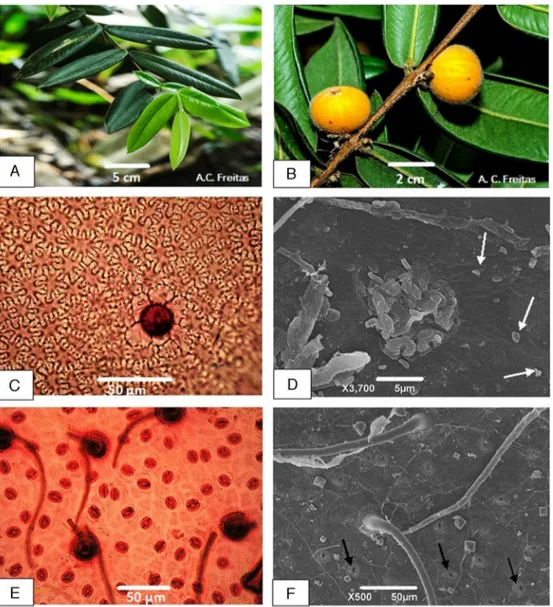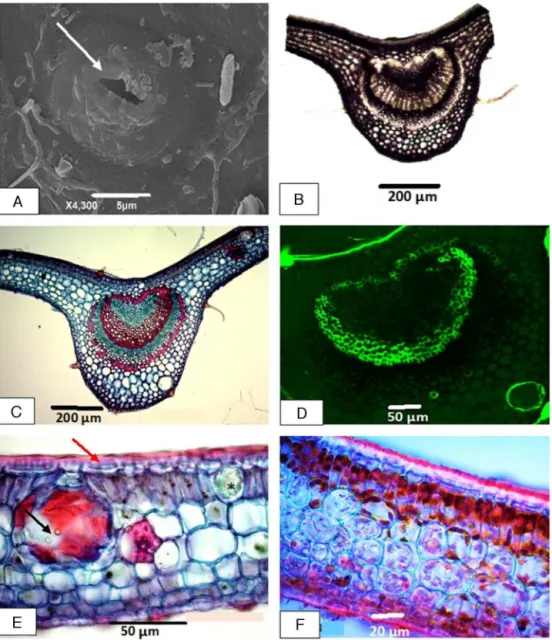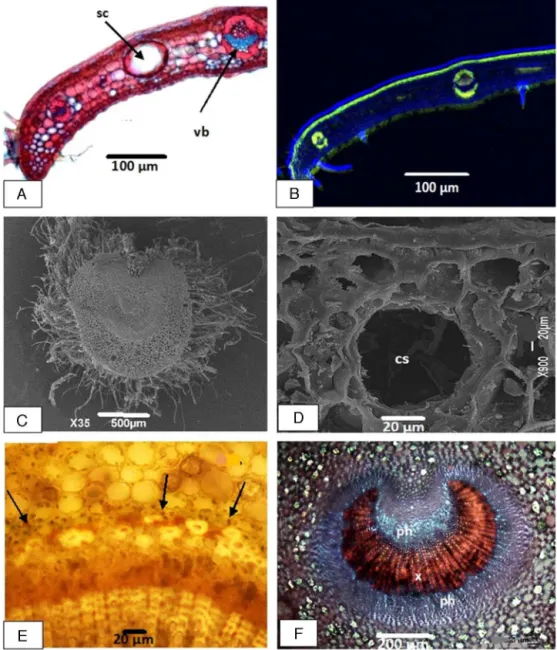w ww . e l s e v i e r . c o m / l o c a t e / b j p
Original
Article
Morpho-anatomy
of
the
leaf
of
Myrciaria
glomerata
Nemes
Veiga
Pacheco-Silva,
Ana
Maria
Donato
∗DepartmentofPlantBiology,UniversidadedoEstadodoRiodeJaneiro,RiodeJaneiro,RJ,Brazil
a
r
t
i
c
l
e
i
n
f
o
Articlehistory:
Received10August2015 Accepted8December2015 Availableonline4January2016
Keywords:
Confocalmicroscopy Foliaranatomy Histochemicaltests Medicinalplants
Scanningelectronmicroscopy Qualitycontrol
a
b
s
t
r
a
c
t
MyrciariaglomerataO.Berg.,Myrtaceae,popularlyknownas“cabeludinha”,hashighcontentof ascor-bicacidandanti-inflammatorypropertyandisusedinfolkmedicine.Theobjectivesofthisstudywere themorphological,anatomicalandhistochemicalcharacterizationoftheleaves.Leafstudiesweremade withoptical,scanningelectronandconfocalmicroscopy.Thecollectionofbotanicalmaterialwasheldat theTijucaForest,RiodeJaneiro,RJ.Histochemicaltestsaimedtheidentificationoflipids,starchgrains, phenoliccompoundsandcrystals.Theleavesaresimple,opposite,lanceolate,pinnate,hairy,with invo-lutemargins,hypostomaticanddorsiventral.Thestomataareanomocytic.Theepidermispresentssimple trichomes.Epidermalcellsshowuneventhickeningoftheirpericlinalouterwalls,mainlyontheadaxial sideoftheleaf.Secretorycavitiesofessentialoilsaresubepidermalandexceed,inheight,thepalisade parenchyma,formedbyonecelllayer.Fourtofivecellularlayers,richinphenoliccompoundsandlipids formthespongyparenchyma.Thebundlesarecollateralandtherearemanycrystalsofcalciumoxalate spreadthroughoutthemesophyll.Inthemidribandpetiolethebundlesarebicollateral.Analysisby scanningelectronrevealedepicuticularwaxrod-shapedandasgrains.Inconfocalmicroscopy,the adax-ialepidermis,thefibersandthesecretoryepitheliumofthecavitiesshowautofluorescence.Thedata obtainedareimportantinqualitycontrolexamsofsamplesofthisspecies.
©2015SociedadeBrasileiradeFarmacognosia.PublishedbyElsevierEditoraLtda.Allrightsreserved.
Introduction
Contemporarytherapeuticuses drugs obtainedfromvarious sources,whichmaybesyntheticornatural.Naturalsourcesare plants, animals or mineral(Kviecinski, 2013). Since the begin-ningofhumanity,manhasusedplantsfor reliefandhealingto manydiseases,thusconstitutingoneoftheoldestformsof med-icalpractices(Serafin,2006;Fischer,2007;Salvaginietal.,2008; Lopes,2008; Niehuesetal., 2011).Theuseof medicinalplants hasbeenencouragedbytheWorldHealth Organizationsinceit realized that about 80% of the population turns to the popu-larculturetogetridofdiseases (Salvaginietal.,2008;Niehues etal.,2011).Manyfactorshavecollaboratedinthedevelopment ofhealthpracticesusingmedicinalplants,includingeconomicand social.
Theallopathictherapyshowedtobeeffectiveagainstvarious diseases,butinmany,itappearsalowsurvivaltime,asinthecase oflungcancer.Severaltherapiesareassociatedinordertoreach betterresults(Begalli,2013),suchaschemotherapy,whichisthe useofdrugsthataimtodestroythecancerouscellsbyblockingtheir
∗ Correspondingauthor.
E-mail:amdonato@uerj.br(A.M.Donato).
development.AccordingtoMesquita(2009),themajorityofthese medicinesareobtainedfromplants,microorganismsandmarine organismsinwhichthereisawidevarietyofcompoundsthatact bydifferentmechanisms.
In thissense,theuseof plantswithmedicinalpropertiesas extracts,essentialoilsandphytochemicalhavegrownin impor-tanceinthecurrenttherapy(Francoetal.,2005;Pereiraetal.,2006; Mesquita,2009;Kviecinski,2013).
TheobjectofthisstudywasMyrciariaglomerataO.Berg., popu-larlyknownas“cabeludinha”.ItbelongstoMyrtaceaefamily,which standsoutintheplantkingdombecausepresentsawiderange ofspecieswithmedicinalpotential(Fevereiro,1996).Besidesthe highascorbicacidcontentinM.glomerata(Malavoltaetal.,1956) andpositive antimicrobialproperty(Serafinetal.,2007),recent studiesarehighlightingitsanalgesicproperties,whichwouldbe much more powerful than the leaders of market in this cate-gory(Fischeretal.,2008;John,2010).Inthisscenario,theuseof M.glomerataas anatural drugishighly encouraged.Thisplant is alsoknownbythesynonyms Pliniaglomerata,Eugenia cabel-luda and Eugenia tomentosa(Serafinet al., 2007; Fischeret al., 2008).
Theobjectivesofthisworkweretostudythemorphological andanatomicalcharacteristicsoftheleavesofMyrciariaglomerata tosubsidizequalitycontroltests.
http://dx.doi.org/10.1016/j.bjp.2015.12.002
ThematerialstudiedwascollectedintheTijucaForest,Estrada dasFurnas,n◦ 1984,AltodaBoaVista(collectionpermitICMBIO 43972-1)insertedintheAtlanticForest,whichischaracterizedby havinghighrainfallandmildtemperatures.Machado(1992)refers totheforestoftheTijucaNationalParkasdensetropicalrainforest. MyrciariaglomerataO.Berg.,Myrtaceae,hasapproximately3–4m inheightand10cmindiameter.Theidentificationofthematerial wasperformedbyCarlosAlbertoLealdeOliveiraandconfirmedin comparativeanalysisattheHerbariumAlbertoCastellanos–GUA. ExsicatashavebeendepositedintheHerbariumoftheUniversity oftheStateofRiodeJaneiroundertheregistrationnumberHRJ 012450.
Themorphologicalstudywasheldbyexaminingthesamples withnakedeyeandarulerwasusedtomakethemeasurementsof theleafbladeandpetiole.Thirtyleaveswereusedandthe arith-meticmeanwascalculated,consideringthewidthandlengthof thebladeandthelengthofpetiole.Thevenationpatternwas estab-lishedbasedonOliveiraandAkisue(1989).
slidesweremadebyfreehandsectionsfromthemedianthirdof theleafbladeandpetiole,accordingtotheusualtechniques(Kraus andArduin,1997).Epidermalfragmentswereremovedforsurface analysis,usingJeffrey’ssolution(Johansen,1940).Thestainwasa mixtureofsafraninandastrablue(Bukatsh,1972).
Histochemicalteststohighlighttheoccurrenceofstarchgrains, lipidsandphenoliccompoundswereperformedinfreshsections ofthematerial,usinglugol,Sudan IVandsolutionofironsalts, respectively(Johansen,1940).Thechemicalnatureofthecrystals wasanalyzedbyitssolubilityinacids(HowarthandWarne,1959). Theregistrationofanatomicalsectionswasheldin photomi-crographsobtainedwiththeaidof anoptical photomicroscope PrimoStarZeisscoupledtoacomputer.Slidesusedforthe opti-cal microscopy (OM) were also analyzed and photographed in confocalmicroscope(CM)Zeiss 510METAwithZEN 2009 soft-ware.
ForexaminationwithJEOLscanningelectronmicroscope(SEM), leaffragmentsweredehydratedinascendingethanolseries,taken
Fig.2.Myrciariaglomerata–(A)DetailoftheabaxialsurfaceinSEM.Stomata(whitearrow),epicuticularwaxrod-shapedandasgrains.(B)Crosssectionofmidrib. Histochemicaltestforphenoliccompounds.Positivereactionondarkercells.(C)Crosssectionofmidribstainedwithastrablueandsafranin.Notethevascularsystem.(D) Confocalmicroscopy,showingthemidrib.Itisvisibletheautofluorescenceofthefibers,cuticleandtheepitheliumofthesecretorycavity.(E)Crosssectionofleafblade, showingthedorsiventralmesophyll.Notethewallprojectionsontheepidermalcells(redarrow),thesecretorycavity(blackarrow)andadruse(*).(F)Positivehistochemical testoflipidsinleafblade(dropletsandcuticleredcolored).
tothecriticalpoint,usingtheCPD-30dryer,andthen,platedwith gold.
Results
Morphology
TheleavesofM.glomerataaresimple,opposite,lanceolate, pin-natewithacollectingmarginalvein.Thetextureischartaceous. Thecolorisbrightdarkgreenontheadaxialsurfaceandmatelight greenontheabaxialone.Thissideisstronglyhairy.Themedianrib isprominentontheabaxialsurfaceandtheedgesoftheleavesare curveddown(Fig.1AandB).Theblademeasures3–4cmwideand 9–11cmlong.Thepetioleis1mmlongandistwisted.
Leafanatomy
TheleafofM.glomerataishypostomaticanddorsiventral.The epidermisisuniseriateandpresentssignificantthickeningofthe
cuticle.Themesophyllhasoilsecretorycavitiesandcalciumoxalate crystalsintheformofdruses.
Fig.3. Myrciariaglomerata–(A)crosssectionofleafmargin:sc=secretorycavity;vb=vascularbundle.(B)Idem,inconfocalmicroscopy.Notetheautofluorescenceofthe fibersandadaxialepidermis.(C)CrosssectionofthepetioleinSEM.(D)Detailofcorticalregionofpetiole:sc=secretorycavity.(E)Positivehistochemicaltestofstarchgrains inthepetiole(arrows).(F)Middleregionofpetiole,inpolarizedlight,showingdrusesinparenchymatouscells(bright)andvascularsystem:x=xylem;ph=phloem.
Themidrib,incrosssection,showsaslightconcavityinthe adax-ialsideandisconvexintheabaxialsurface.Theepidermalcellsare smallerthanthoseoftheremainingleafblade.Thereare2–3 lay-ersofcollenchymainsubepidermalposition,interruptingtherow ofpalisadeparenchymapresentallovertheextensionoftheleaf blade.Centralythevascularsystempresentsphloemonbothsides ofxylem,surroundedbyfibers(Fig.2C).Inthedorsalregionofthe midriboccuraboutsixparenchymacelllayers.Histochemicaltests revealastrongpositivereactiontophenoliccompounds(Fig.2B) andlipids.InCMthefluorescenceoftheepitheliumofthe secre-torycavitiescanbeobserved,and,inaddition,thefibersandcuticle (Fig.2D).
Theleafblade isdorsiventralwitha singlelayerof palisade (Fig.2EandF),whichisinterruptedbysecretorycavitieswhose dimensionsfarexceedtheheightofthisparenchyma,approaching theabaxialsurface(Figs.2Eand3A).Thespongyparenchymais formedforabout4celllayers.Calcium oxalatedrusesoccurall overthemesophyll.Thebundlesarecollateralsurroundedbyfibers. Thehistochemicaltests denotedplentyof phenolic compounds
throughoutthemesophyll.Inaddition,oildropletsweredetectedin theepidermalandparenchymatouscells(Fig.2F)andinthe secre-tionofthesecretorycavities.Starchgrainsweredetectedinthe parenchyma.
Theleafmarginiscurvedtowardtheabaxialsurface(Fig.3A andB)andpresentsanatomicalfeaturessimilartothosedescribed fortheleafblade.Attheedgethereismechanicaltissue.WithCM, theautofluorescenceoftheperivascularfibersandofthecuticleis highlighted(Fig.3B).
Discussionandconclusions
ThegreathairinessofMyrciariaglomerataleavesgivesavelvety texturethathelpsinspeciesidentificationinthefield.The dimen-sionsandshapeoftheblade,besidesthetypicaloppositephyllotaxy alsocontributetotherecognitionofthespecies.
Histologicalstudyof M.glomerataleafshowseveralfeatures highlightedbySolereder(1908),MetcalfeandChalk(1950),Fiuza etal.(2008),Döll-Boscardinetal.(2010),NunesandMartins(2010), asrepresentativeoftheMyrtaceaefamily,forexamplethe pres-enceofsecretorycavities,locatedbelowtheepidermis,producing essentialoils.Thesecretionofthesecavitieshasacomplexnature becausebeyondthelipids, thereare,in addition,phenolic com-pounds.Essentialoils,accordingtoGotliebandSalatino(1987),are formedbyalargenumberofsubstanceswhosebiodynamic activ-itycanleadtodrugdiscovery.Theseauthorsstate,further,thatthe presenceofdefinedanatomicalstructuresassecretorycells, secre-torycavitiesandglandulartrichomesaremoreimportantforthe recognitionofessentialoilsthantheodoritself,sinceotherplant materialscanalsobearomatic.Lipiddropletsoccurallovertheleaf bladeofM.glomerata,aswellasstarchgrainsandphenolic com-pounds,these,inlargeamounts.Serafinetal.(2007)makealink betweenthephenolic compoundsandtheanalgesicpotentialof thespecies.Costa(1986)statesthatthephenoliccompoundsare veryabundantindicotyledons,particularlyinsomefamilies, cit-ing,amongthese,Myrtaceae.Otherimportantanatomicalfeatures, confirmedinM.glomerata,aretheinternalphloemandthe anomo-cyticstomatarestrictedtotheabaxialfaceoftheleaf(Defaverietal., 2011;Armstrongetal.,2012).
ThemesophyllofM.glomerataresemblesthatspeciesof Myr-taceae as Syzygiumcumini (Nunes and Martins, 2010), Eugenia umbeliflora(Medeiros,2000),Eugeniauniflora(Alvesetal.,2008; Fiuzaetal.,2008),Eugeniabrasiliensis(DonatoandMorretes,2007), Campomanesiaadamantium,Myrciacordiifolia,Myrciadecrescens, Myrcia torta(Gomes et al.,2009).Themesophyll of M. glomer-ataisdorsiventraland thepalisadeparenchyma hasonesingle layerinterrupted by secretory cavities, as are verycommon in Myrtaceae(Sudgen,1985;Jorgeetal.,2000).However,M. glom-eratadiffersfromtheothersspeciesbythelargedimensionsofthe secretorycavities,whichcangofarbeyondtheheightofpalisade parenchyma,approachingtheabaxialface.Thespongyparenchyma hasaboutfourcelllayers,whileinPsidiumwidgrenianum,occur about seven layers (Donato and Morretes, 2005) and in Euge-niabrasiliensisthereare,approximately,ninelayers(Donatoand Morretes,2007).TheorganizationofthemedianribofM.glomerata issimilartotheothersspeciesofMyrtaceae,i.e.,itisof bicollat-eraltypesurroundedbysclerenchyma fibers,resemblinganarc (Machadoetal.,1988;DonatoandMorretes,2005,2007;Fiuzaet al.,2008;Döll-Boscardinetal.,2010;NunesandMartins,2010). Otherspecies showthevascularsystemofthemidribasanarc veryopen,almostflat,asinC.adamantiumor,inaddition,asanarc stronglyclosedasinthreespeciesofMyrcia(Gomesetal.,2009).
Regardingtheepidermis,itisnoteworthytheintracellularwall projectionsthatoccurattheexternalpericlinalwallsoftheadaxial cells,whichgreatlyincreaseitssurface.Thisfeaturewasrecorded inseveralspeciesoftheMyrtaceaefamily,suchassomeGomidesia (Fontenelle etal., 1994),Myrcia (Gomes etal.,2009)and Euge-nia (Machado et al., 1988; Fontenelle et al., 1994; Donato and Morretes,2007)andpossiblycorrelateswiththetransportof essen-tialoilsthatarereleasedtotheatmospherethroughthecoverage cellsofthesecretorycavities.Thisinferencearisesfromthe anal-ogybetweenthis featureandthat namedby Gunningand Pate (1969) as “wall ingrowths” when these authors described the transfercellsassociatedtothetransportofsoluteswithinshort distances.Analysisoftheleafsurfacerevealswhetherthe anti-clinalwalls ofepidermal cellsare straightor wavy,noting that
inM.glomeratathewallsarewindingaswellasinMyrcia cordi-folia,M.decrescens,M.guianensisandM.racemosa(Gomesetal., 2009).The epidermalcells locatedupthesecretory cavitiesare alsoimportantinthesetof diagnosticfeatures.In M.glomerata theseregionsof theepidermiscanberecognizedbya rounded centralcellwhichissurroundedby5–7cellsdisposedradiallyor bya single pairoflargercells. Theappearance ofthecoverage cellsofthesecretorycavitiesisvariable,inshapeandamountof cells,withinthespeciesofMyrtaceae.Gomesetal.(2009)refer that the presence of pairs of cells onthe top of the secretory cavitiesisquitecommonascanbeseeninM.decrescensandM. torta.
Noreferencewasfoundintheliteratureaboutthe autofluores-cenceobservedinthepresentstudy,inthecuticle,inthefibersand intheepitheliumofthesecretorycavities.Probably,thisproperty canbeassociatedwiththetypicalwaterproofingofthese struc-tures.ThisideaissupportedbyAscenc¸ão(2007)thatstatesthat thewallsof oilcells containsuberin,sothatthesecretion pro-ducedbecomesisolated,protectingtheadjacentcellsofthetoxic components.
Themorphologicalandanatomicalcharacteristicscontributeto theidentificationofthisspeciesandsupportqualitycontroltests. Somefeatures maybestandedoutas hairyleaveswithcurved edges;epidermal cellswithripples andwallprojectionsand,in addition,thesecretorycavities withdimensionsthatgobeyond theheightofpalisadeparenchyma.
Authors’contributions
NVPSassistedincollectingandidentifyingplantsamples, pre-paredtheexsiccates,wasresponsibleforpreparingtheslides,data analysis and drafting thepaper. AMD drawed the experiment, conductedandsupervisedlaboratoryexperiments,dataanalysis, microscopyanddraftedthepaper.Bothauthorsundertooka crit-icalreading ofthemanuscript andagreedtoitssubmissionfor appraisal.
Conflictsofinterest
Theauthorsdeclarenoconflictsofinterest.
Acknowledgements
ToMr.CarlosAlbertoLealdeOliveirabythelocalizationofthe speciesatTijucaForestandbytheidentificationoftheplant.To Mr.PauloAlmeidadeJesusandAntonioCarlosTeixeiradeSouza fortheirhelpincollectthebotanicalmaterial.ToDr.JorgeJoséde Carvalho,Mr.LeandroXavierandMr.MárioJosédosSantosPereira forhelpingintheutilizationofconfocalmicroscope.ToFundac¸ão OswaldoCruzbytheuseofthescanningelectronmicroscope.To Dr.AntonioCarlosdeFreitas,forsomeofthephotosthatmakeup thework.
References
Alves,E.S.,Tresmondi,F.,Longui,E.L.,2008.AnáliseestruturaldefolhasdeEugenia unifloraL.(Myrtaceae)coletadasemambientesruraleurbano,SP,Brasil.Acta Bot.Bras.22,241–248.
Armstrong,L.,Duarte,M.R.,Miguel,O.G.,2012.Morpho-anatomyoftheleafand stemofEugeniapyriformis.Rev.Bras.Farmacogn.22,475–481.
Ascenc¸ão,L.,2007. Estruturas secretorasem plantas.Uma abordagem morfo-anatômica.In:Figueiredo,A.C.,Barroso,J.G.,Pedro,L.G.(Eds.),Potencialidades eaplicac¸õesdasplantasaromáticasemedicinais.CursoTeórico-Prático.,3a
ed.Faculdade,deCiênciasdaUniversidadedeLisboa–CentrodeBiotecnologia Vegetal,Lisboa,Portugal.
Defaveri,A.C.A.,Arruda,R.C.O.,Sato,A.,2011.Leafanatomyandmorphologyof Euge-niarotundifoliaappliedtotheauthenticationoftheabajurúcommerciallysold. Rev.Bras.Farmacogn.21,373–381.
Döll-Boscardin,P.M.,Farago,P.V.,Nakashima,T.,Santos,P.E.T.,dePaula,J.F.P.,2010.
Estudoanatômicoeprospecc¸ãofitoquímicadefolhasdeEucalyptusbenthamii MaidenetCambage.Lat.Am.J.Pharm.29,94–101.
Donato,A.M.,Morretes,B.L.,2005.EstudoanatômicodasfolhasdePsidium widgreni-anum(Myrtaceae),umapotencialespéciemedicinal.Rev.Bras.Farmacogn.86, 65–70.
Donato,A.M.,Morretes,B.L.,2007.AnatomiafoliardeEugeniabrasiliensisLam. (Myr-taceae)provenientedeáreasderestingaedefloresta.Rev.Bras.Farmacogn.17, 426–443.
Fevereiro,P.C.A.,1996.Aspectosbotânicos.In:Braganc¸a,L.A.R.(Ed.),Plantas medic-inaisantidiabéticas.Umaabordagemmultidisciplinar.EDUFF,Niterói.
Fischer,L.G.,(Dissertac¸ãodeMestrado,ProgramadePós-graduac¸ãoemCiências Farmacêuticas)2007.Avaliac¸ãofarmacológicadeextratosesubstânciasobtidas dePliniaglomerata.UniversidadedoValedoItajaí,Itajaí,91pp.
Fischer,L.G.,Santos,D.,Serafin,C.,Malheiros,A.,Monache,F.D.,CechinelFilho,W., Souza,M.M.,2008.Furtherantinociceptivepropertiesofextractsand pheno-liccompoundsfromPliniaglomerata(Myrtaceae)leaves.Biol.Pharm.Bull.31, 235–239.
Fontenelle,G.B.,Costa,G.C.,Machado,R.D.,1994.Foliaranatomyand micromor-phologyofelevenspeciesofEugeniaL(Myrtaceae).Bot.J. Linn.Soc.115, 111–133.
Fiuza,S.T.,Rezende,M.H.,Sabóis-Morais,S.M.T.,Bara,M.T.F.,Tresvenzol,L.M.F., Paula,J.R.,2008.Caracterizac¸ãofarmacognósticadasfolhasdeEugeniauniflora L.(Myrtaceae).Rev.Eletron.Farm.5,1–11.
Franco,J.,Nakashima,T.,Franco,L.,Boller,C.,2005.Composic¸ãoquímicaeatividade antimicrobianainvitrodoóleoessencialdeEucaliptuscinereaF.Mull.exBenth. Myrtaceae,extraídoemdiferentesintervalosdetempo.Rev.Bras.Farmacogn. 15,191–194.
Gomes,S.M.,Somavilla,N.S.D.N.,Gomes-Bezerra,K.M.,Miranda,S.C.,Carvalho, P.S.,Graciano-Ribeiro,D.,2009.AnatomiafoliardeespéciesdeMyrtaceae: contribuic¸õesàtaxonomiaefilogenia.ActaBot.Bras.23,223–238.
Gotlieb,O.R.,Salatino,A.,1987.Func¸ãoeevoluc¸ãodeóleosessenciaisedesuas estruturassecretoras.Ciênc.Cult.39,707–716.
Gunning,B.E.,Pate,J.S.,1969.“Transfercells”–plantcellswithwallingrowths spe-cializedinrelationtoshortdistancetransportofsolutes–theiroccurrence, structureanddevelopment.Protoplasma68,107–133.
Howarth,W.,Warne,L.G.G.,1959.PracticalBotanyfortheTropics.Univ.ofLondon Press,London.
John, L., 2010. Alívio é com a cabeludinha. http://www.planetasustentavel. abril.com.br/blog/biodiversa/alivio-cabeludinha-257028/ (accessed August 2013).
Johansen,D.,1940.PlantMicrotechnique.McGrawHillBook,NewYork.
Kviecinski,M.R.,(TesedeDoutoradoemBioquímica)2013.Atividadeantitumoral deextratosdeBidenspilosaLinnéricosempoliacetilenosedejuglonaassociada aoascorbato.UniversidadeFederaldeSantaCatarina,144pp.
Lopes,M.M.,Dissertac¸ãodeMestradoemCiências,ProgramadePós-graduac¸ãoem Agroquímica2008.Composic¸ãoquímica,atividadeantibacterianaealelopática dosóleosessenciaisdeEugeniaunifloraL.eMyrciariaglazioviana(Kiaersk)G. M.Barroso&Sobral(Myrtaceae).UniversidadeFederaldeVic¸osa,MinasGerais, 48pp.,http://www.bibliotecaflorestal.ufv.br/handle/123456789/2757. Machado,J.P.,1992.ParqueNacionaldaTijuca.Agir,RiodeJaneiro.
Machado,R.D.,Costa,C.G.,Fontenelle,G.B.,1988.AnatomiafoliardeEugeniasulcata SpringexMart(Myrtaceae).ActaBot.Bras.1(Supl.),275–285.
Malavolta,E.,LemeJun,J.,Gurgel,J.T.A.,SoubiheSobro,J.,1956.Ascorbicacidcontent infruitsofMyrciariaglomerataBerg.Nature178,424.
Medeiros,J.D., 2000.Anatomia foliardeEugeniaumbeliflora Berg(Myrtaceae). Biotemas13,7–20.
Mesquita,M.L.,(TesedeDoutoradoemCiênciasMédicas)2009.Potencial anti-tumoralde substânciasisoladasde plantasdocerrado brasileiro:estudos preliminaresdomecanismodeac¸ãodaatividadecitotóxica.Universidadede Brasília,Brasília,223pp.
Metcalfe,C.R.,Chalk,L.,1950.AnatomyoftheDicotyledons,vol.1.ClarendonPress, Oxford.
Niehues,J.,Bonetti,B.,Souza,M.R.,Maia,A.L.,Piovezan,A.P.,Peters,R.R.,2011. Lev-antamentoetnofarmacológicoeidentificac¸ãobotânicadeplantasmedicinaisem comunidadesassistidasporumservic¸odesaúde.Arq.Catarin.Med.40,34–39.
Nunes,S.A.,Martins,M.B.G.,2010.EstudoanatômicodefolhasdeSyzygiumcumini (L.)Skeels(Myrtaceae).Rev.Biociênc.UNITAU16,116–122.
Oliveira,F.,Akisue,G.,1989.Fundamentosdefarmacobotânica.Atheneu,Riode Janeiro.
Pereira,M.C.,Vilela,G.R.,Costa,L.M.A.S.,Silva,R.F.,Fernandes,A.F.,Fonseca,E.W.N., Piccoli,R.H.,2006.Inibic¸ãododesenvolvimentofúngicoatravésdautilizac¸ãode óleosessenciaisdecondimentos.Cienc.Agrotec.Lavras30,731–738.
Salvagini,L.E.,Oliveira,J.R.S.,Santos,L.E.,Moreira,R.R.D.,Pietro,R.C.L.R.,2008.
Avaliac¸ãodaatividadeantibacterianadefolhasMyrtuscommunisL.(Myrtaceae). Rev.Bras.Farmacogn.18,241–244.
Serafin,C.,(Dissertac¸ãodeMestrado,ProgramadePós-graduac¸ãoemCiências Far-macêuticas)2006.Estudodacomposic¸ãoquímicaedaspropriedadesbiológicas daspartesaéreasdePliniaglomerata.UniversidadedoValedoItajaí,Itajaí,84 pp.
Serafin,C.,Nart,V.,Malheiros,A.,Cruz,A.B.,Monache,F.D.,Gette,M.A.,Zacchino, S.,CecchinelFilho,V.,2007.Avaliac¸ãodopotencialantimicrobianodePlinia glomerata(Myrtaceae).Rev.Bras.Farmacogn.17,578–582.
Solereder,H.,1908. SystematicAnatomyoftheDicotyledons.ClarendonPress, Oxford.


